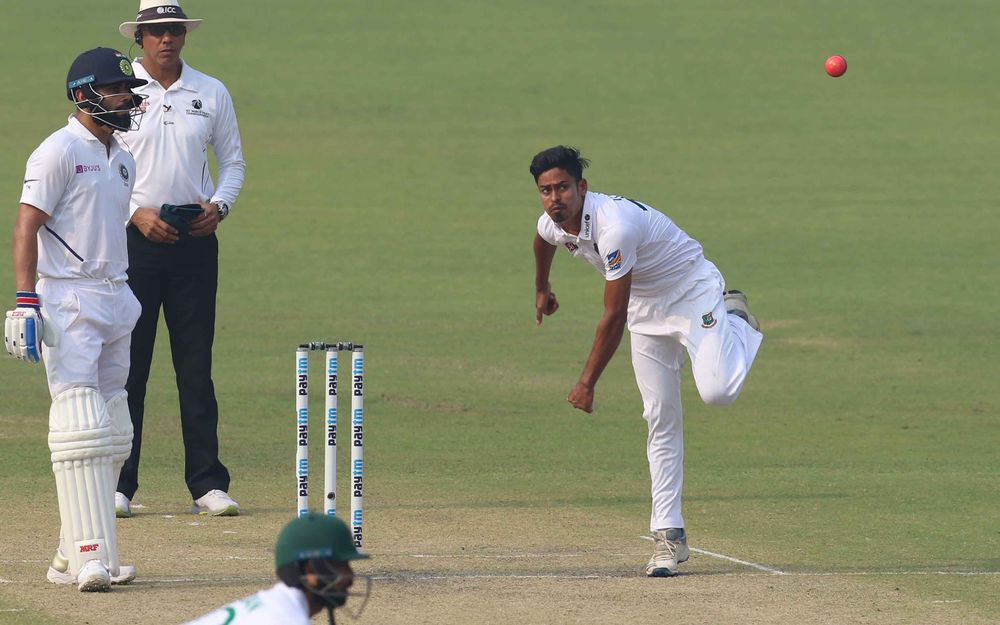IND vs BAN | Kolkata Day 2 Talking Points: Of Ishant Sharma's glorious run and Bangladesh's sloppiness
By the time Virat Kohli had reached his fifty, India already had a potential match-winning edge over Bangladesh. It was the visitors' lack of intent and understanding that ruined their chances while it was Ishant Sharma ruling once again. The only positive that Bangladesh had was Taijul Islam.

Mahmudullah’s lazy approach reflects bigger problems
No Shakib Al Hasan in the weaponry, two players retired due to concussion and a clueless captain. Everything that could go wrong for Bangladesh did go wrong. And add to it was Bangladesh’s ever so long sloppiness on the field. In a Test match where Wriddhiman Saha was diving left and right, Bangladesh were all over the place. Leaking runs, dropping catches and do everything that could go wrong on a cricket field.
Designated wicket-keeper Liton Das, gone. His replacement, Mohammad Mithun. That’s replacing a mediocre wicketkeeper with a worse one. Shakib Al Hasan, the only true all-rounder in Bangladesh cricket, banned. His replacement? Genuinely, none. Bangladesh was always relying on a one-man show.
Mominul Haque might be the captain of the side but he has no leadership skills whatsoever. Al-Amin Hossain’s dropped catch of Rohit Sharma on Day 1 actually highlights the entire field setup for Bangladesh, which would extend to Day 2. The fact that Mahmudullah’s lack of intent was vibing out through his fielding made Bangladesh’s attack look all weaker. Kohli had punched one to the cover-point where Mahmudullah was fielding. The absent-minded senior player took his eyes off the ball and let it through his legs. For this second-string Bangladesh team, Mushfiqur Rahim and Mahmudullah should be the ones imparting inspiration. But while one got out for a duck, the other looked disturbingly lazy.
Taijul Islam’s performance arc a positive takeaway for Bangladesh
Taijul Islam, a concussion substitute for Nayeem Hasan, was incorporated into the bowling attack pretty early in the innings. India, on the other hand, didn’t use Ravichandran Ashwin at all. But like other strategies picked up by India, Bangladesh didn’t seem too convinced with it. The argument to bring in Taijul being an absolute necessity was negated by the fact that he was anything but a substitute. But the way the left-armer bounced back into the game, it might have made Bangladesh wonder why didn’t they select him in the first place.
However, that’s not the concern. The fact that Mominul Haque used him without any pre-planning in mind, could’ve been a disaster. After the spinner went for 23 runs in his eight overs without a wicket on Day 1, Bangladesh started the day’s spell with him when they could’ve started with other wicket-taking options. It took a good eight more overs for Taijul to get a breakthrough for Bangladesh, a sigh of relief. That, one could say, was the end of mediocrity for the Bangladeshi spinner - especially for the way he dismissed Ajinkya Rahane. In his previous over, Taijul had posed some threat with slow turn and it was the same batsman facing. And the wicket delivery was a rank slower one which finally saw Rahane’s back. So it can be said that the bowler had laid the perfect plan to dismiss Rahane.
Once again, while Bangladesh’s fielding was in shambles, it was Taijul who brought in the major breakthrough for Bangladesh. The fielder took a ‘leap of faith’ in bagging a flying two-handed catch off a perfectly timed shot, which was destined to clear the boundary, by Virat Kohli. A day that started with a disaster ended up being a decent one.
Ishant Sharma’s rare wisdom the reason behind his success
By claiming five wickets in the first innings, Ishant became the first-ever Indian bowler to bag a five-wicket haul in a pink-ball Test. In the second innings too, at the end of Day 2, he claimed four out of six wickets, proving it wasn’t a one-time show but he had turned his grasp over the pink ball into unparalleled expertise.
With this form, the Indian paceman looks better than ever. Just about a month ago, the now so confident Ishant had expressed his concern over his career saying, “If I don't take wickets even in one innings, I think my career for India is over.” From then to now, it hasn’t been a long time but for the man in question, it has been a defining span. After a good show in Indore, the pink ball in Kolkata came in as a new challenge. Ishant has been better than any other bowler in this contest and that has only been possible because of his wisdom, more than his confidence. "Earlier I used to put pressure on myself about performing. Now I don't think too much about those things, just how to take wickets,” the bowler revealed after his five-wicket haul on Day 1.
Pink ball cricket was untested territory, but that feeling was short-lived as Ishant set the correct tone for how the lengths should be. He was clear in his head and leaving the pacer’s ego behind, a rare wisdom. Usually, a pacer would - on not getting any breakthrough with bowling decent lengths - try different lengths in order to catch the batsman off guard or out of frustration but Ishant had the clarity to stick to his plans. "In the start, we bowled a normal length, it wasn't swinging that much. After that, we realised what lengths we need to be hitting in order to get some more help. So the three of us [fast bowlers] communicated about hitting the right length," were Ishant’s words after his five-wicket haul on Day 1. And that’s how India cracked the pink ball code.

Comments
Sign up or log in to your account to leave comments and reactions
0 Comments